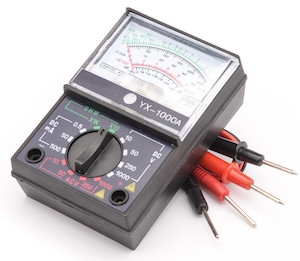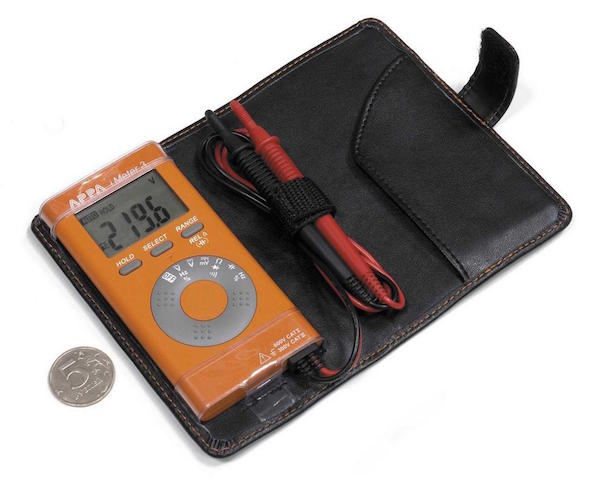Multimeters: which device is better to choose
In most cases, the performance of work related to electricity, without a qualitative measurement of such characteristics as current strength, resistance, voltage, becomes almost impossible. For the convenience of performing such operations, a universal measuring device is used - a multimeter (in another way it is often called a tester). A huge number of models that differ in their characteristics, functionality, and measurement limits are produced. Therefore, it is possible to decide which multimeter is better to choose only based on the features of its future use and the wishes of the buyer.
Content
Modern multimeter and its capabilities

Until two decades ago, such measuring devices were called avometers and were able to measure only the current, voltage or resistance in a circuit. Today, with the help of their modern counterpart, you can determine with high accuracy the parameters of electronic components, network frequency, temperature, inductance, capacity. A good multimeter at home will allow you to easily detect an open wire, determine the presence of voltage on the car battery or in the outlet. For a specialist (for example, a home appliance repairman), other opportunities will also be relevant, allowing you to quickly and accurately identify faults in an electrical part or an electronic unit.
Equipment classes: household and professional multimeters
When it comes to measuring instruments, the main pricing parameters are not only the brand, but also the accuracy class, functionality, and measurement range. Depending on their combination, the cost of the selected model may differ several times, so it is important to initially determine your own requirements for the device. This approach will optimize costs while choosing a device that will fully meet all the needs of its owner.
Household multimeters
When choosing which multimeter to buy for home use, it is important to consider that it must work over a wide range to ensure the versatility of the device. Standard functions - measurement of current, voltage, resistance, continuity. Expansion of capabilities and additional "bells and whistles" (availability of memory, connectivity to a computer, rotary display) in this case become a matter of personal preference and financial capabilities, but not a mandatory requirement. Most often, for home use, a budget class multimeter becomes the best solution. This does not mean that the first inexpensive Chinese device that comes across is suitable: accuracy and reliability in this case are not a wish, but a condition for safe work with electricity.
Professional multimeters

For specialists, the choice of a multimeter is based on the fact that it is convenient to carry out measurements in any conditions, to determine all kinds of parameters depending on the characteristics of the task at hand. In this case, the readings should be as informative as possible (for example, it is important to determine not only the value of the parameter, but also the dynamics of its change depending on the accompanying data).
As for additional options, which are often offered by manufacturers in order to simply raise the popularity of the presented model, this is a matter of taste. Many of them can only be useful in the work of specialists in the field of electrical and electronics. As practice shows, using a multimeter for home the maximum that may be required is additional display illumination, while professionals need more options:
- generation of test signals,
- output of graphic information,
- automatic limit selection,
- retention of readings obtained,
- testing of semiconductor devices,
- determination of root-mean-square parameters, which are especially relevant in
- work with power networks operating with non-linear loads.
Digital or analog multimeters

Most often, the main task is to choose the right multimeter among the electronic (digital) and analog (pointer) models on the market. Despite the fact that the first option seems to be more convenient and modern, the second does not give up its positions. In order to make a choice based on objective indicators, we suggest analyzing their main characteristics.
| Main characteristics | Analog multimeter | Digital multimeter |
|---|---|---|
| Convenience of determining readings. | It is necessary to know the division price, to carry out calculations in order to obtain measurable indicators. Accuracy of captured data may decrease depending on the angle of view of the scale. | Ready data will be displayed, no additional calculations are required. |
| Functionality | The devices have relatively little functionality. | Different types of multimeters are available with a different set of functions from minimum to maximum. |
| Compliance with polarity. | If the polarity is not observed when the tester is connected, the arrow will deviate beyond the scale. | The measurement will be carried out in any case, non-observance of polarity will be indicated by a “-” sign in front of the number. |
| Ability to determine the dynamics of changes in readings | Depending on the current electrical parameters of the network, the position of the arrow changes, which allows the user to easily identify the dynamics. | It is impossible to determine the dynamics of changes in readings. |
| Operation of devices in conditions of interference. | The multimeter test shows that the results obtained are not affected by interference during measurements. | Measurement results are distorted. |
| Energy consumption. | Power is not always necessary (only to determine the resistance of the circuit). | Required for any measurement, so the batteries will need to be replaced more often. |
| Dependence of the accuracy of the readings obtained on the battery charge level. | Insufficient battery charge may be indicated by a discrepancy between the position of the arrow and the "zero" and the need to set it to the desired position manually. | If the battery is half-discharged, the meter reading may be inaccurate. |
| Impact resistance. | Low (pointer devices do not allow mechanical stress or shock, from which they fail). | High (largely due to the presence of a shock-absorbing shell, which is provided by the device of most instrument cases). |
If you analyze the table above, you can see that both options have significant advantages. That is why today combined models are very popular, which combine both a digital multimeter and a pointer in one device.
Such a device will eliminate all the inconveniences of using analog models and at the same time will make it possible to record the dynamics of changes in indicators. Analog measuring instruments are uniquely professional equipment. But if the question is about which multimeter to choose for the home, then for most users it will be more convenient and simple to work with digital devices.
Criteria for choosing multimeters: which model is better to choose
Measured parameters
In practice, the main parameters in working with electrical circuits are measuring current and voltage; in addition, it may be necessary to determine the resistance of the circuit or its continuity. Sometimes it becomes necessary to determine the integrity of semiconductor devices and measure the capacitance. All other functions (such as a frequency generator, an inductance meter, etc.) may be needed only by professionals who, when choosing equipment, know in advance exactly what they will need to work.
Electrical safety class
In working with electrical circuits, safety is of paramount importance when choosing measuring instruments. Today, all models presented by manufacturers are usually divided into 4 categories (CAT I and CAT IV). In fact, they differ among themselves in the possibilities of using a multimeter.
- Devices of this class can only be used to work with circuits of small ratings (these can be signal, telephone, computer lines).
- The electrical safety class of the device allows you to freely work with apartment wiring.
- The equipment allows carrying out measurements in power distribution boards located on the floor, repairing car wiring.
- Professional equipment with the highest level of protection that can be used in the maintenance and repair of power lines to buildings.
Overall dimensions of the device

Today, there is a huge selection of devices of different sizes. Compact pocket models are lightweight, take up a minimum of free space, so they are most often used as a household appliance. It has a positive effect on the popularity of multimeters of this class and their relatively low cost. But on the other hand, before buying, it is worth considering the fact that they differ in smaller display (scale) sizes, which can create inconvenience when reading readings in people with low vision.
Measurement limits
When measuring devices are used in the home, the measurement limits are sufficient.
- by voltage for AC lines - up to 650 V, DC - up to 1000 V;
- by current for constant up to 10 A, and for alternating - up to 20 A;
- resistances ranging from units of Ohm to several megohms (according to the current edition of the PUE, the insulation state can only be determined using a megohmmeter, the multimeter allows you to determine only the approximate state of the cable insulation).
Bit depth
The bit depth is a measure of the number of decimal places that will be displayed on the screen during measurements. It should be noted that for domestic use, this parameter actually does not matter, more accurate models are needed only in the work of professionals. The bit depth can vary in the range of 2.5 ÷ 6.5 (the readings will indicate from hundredths to ppm, respectively). Therefore, when choosing the optimal multimeter for the home, it is worth stopping at the level of 3.5, in buying a more expensive modification, despite all its accuracy, in this case there is simply no point.
The presence of measuring clamps or probes
The presence of a measuring clamp is one of the additional features that is very convenient for both home users and professionals. They allow you to immediately diagnose the line for a break, to determine the complete absence of voltage at all or only at one of the phases. To carry out circuit diagnostics, it will not be necessary to remove the insulation or turn off the circuit breaker, access to which is often limited. At the same time, using thin probes, it becomes possible to carry out measurements with small electronic elements in places with difficult access.That is why when choosing, it is worth focusing, if possible, on models that allow, if necessary, use the desired type of tool.
Display options

Modern models may have one or more digital displays. The second option is more convenient for specialists who have to measure several circuit parameters at once during their work. As a result, each of them will be displayed on a separate display, stored in memory, which allows you not to specifically record the data on paper. Screen size is also an important parameter. Before choosing a multimeter, it is important to keep in mind that working conditions will not always be convenient for the user. Therefore, it is worth taking into account not only the vision, but also the distance from which the data will need to be read.
Conclusion
From the foregoing, we can conclude that when choosing a multimeter, you should focus primarily on the features of its future use. For domestic use, you can choose both the simplest model from China (in the Middle Kingdom, they do not always produce products that do not deserve our attention), and a multifunctional device from a leading manufacturer. It all depends on personal preferences and financial capabilities.
For professionals, functionality, accuracy and stability in work are most important. The choice of modification is largely determined by the scope of the multimeter, therefore, specialists, as a rule, based on their own experience, can judge the relevance of one or another function for them. This allows them to choose the best option in terms of a combination of all technical parameters and the cost of the device.




